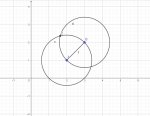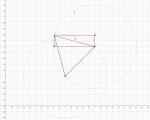You are using an out of date browser. It may not display this or other websites correctly.
You should upgrade or use an alternative browser.
You should upgrade or use an alternative browser.
find coordinates of an equilateral triangle(two points given)
- Thread starter alextm
- Start date
For now, I'll work with your two example points. Using the distance formula and knowing that the two points A and B must be equidistant from C, we get:
\(\displaystyle \sqrt{(2 - X_C)^2 + (1 - Y_C)^2} = \sqrt{(3 - X_C)^2 + (2 - Y_C)^2}\)
If we expand everything out, we get:
\(\displaystyle \sqrt{(X_C)^2 - 4X_C + (Y_C)^2 - 2Y_C + 5} = \sqrt{(X_C)^2 - 6X_C + (Y_C)^2 - 4Y_C + 13}\)
Now, for any positive x and y, we have the property that \(\displaystyle \sqrt{x} = \sqrt{y} \implies x = y\). Since distance is always positive, we can just "delete" the square roots:
\(\displaystyle (X_C)^2 - 4X_C + (Y_C)^2 - 2Y_C + 5 = (X_C)^2 - 6X_C + (Y_C)^2 - 4Y_C + 13\)
Collecting all the variable terms on one side and the constants on the other, we see that the squared terms cancel out and we're left with:
\(\displaystyle 2X_C + 2Y_C = 8 \implies X_C + Y_C = 4\)
It should be easy enough for you to do the last step and figure out where this line intersects your circles. In fact, because you know the circles also intersect with each other at these points, it would be sufficient to find where the line intersects with one of them. And finally, what would happen if we left the coordinates of A and B as unknown? Well, we'd have:
\(\displaystyle (X_A - X_C)^2 + (Y_A - Y_C)^2 = (X_B - X_C)^2 + (Y_B - Y_C)^2\)
Try continuing from here and see what you can come up with.
\(\displaystyle \sqrt{(2 - X_C)^2 + (1 - Y_C)^2} = \sqrt{(3 - X_C)^2 + (2 - Y_C)^2}\)
If we expand everything out, we get:
\(\displaystyle \sqrt{(X_C)^2 - 4X_C + (Y_C)^2 - 2Y_C + 5} = \sqrt{(X_C)^2 - 6X_C + (Y_C)^2 - 4Y_C + 13}\)
Now, for any positive x and y, we have the property that \(\displaystyle \sqrt{x} = \sqrt{y} \implies x = y\). Since distance is always positive, we can just "delete" the square roots:
\(\displaystyle (X_C)^2 - 4X_C + (Y_C)^2 - 2Y_C + 5 = (X_C)^2 - 6X_C + (Y_C)^2 - 4Y_C + 13\)
Collecting all the variable terms on one side and the constants on the other, we see that the squared terms cancel out and we're left with:
\(\displaystyle 2X_C + 2Y_C = 8 \implies X_C + Y_C = 4\)
It should be easy enough for you to do the last step and figure out where this line intersects your circles. In fact, because you know the circles also intersect with each other at these points, it would be sufficient to find where the line intersects with one of them. And finally, what would happen if we left the coordinates of A and B as unknown? Well, we'd have:
\(\displaystyle (X_A - X_C)^2 + (Y_A - Y_C)^2 = (X_B - X_C)^2 + (Y_B - Y_C)^2\)
Try continuing from here and see what you can come up with.
- Joined
- Nov 24, 2012
- Messages
- 3,021
I would let the coordinates of \(\displaystyle C\) be \(\displaystyle (x,y)\). Now, if we equate the square of \(\displaystyle \overline{AC}\) to the square of \(\displaystyle \overline{BC}\), there results:
\(\displaystyle (x-2)^2+(y-1)^2=(x-3)^2+(y-2)^2\)
You should be able to show this reduces to:
\(\displaystyle y=-x+4\)
We should not be surprised to find this it the line perpendicular to \(\displaystyle \overline{AB}\) which passes through the midpoint of this same segment. The slope of \(\displaystyle \overline{AB}\) is:
\(\displaystyle m=\frac{2-1}{3-2}=1\)
And the midpoint is:
\(\displaystyle \left(\frac{2+3}{2},\frac{1+2}{2}\right)= \left(\frac{5}{2},\frac{3}{2}\right)\)
And so the line we want is:
\(\displaystyle y-\frac{3}{2}=-\left(x-\frac{5}{2}\right)\)
\(\displaystyle y=-x+4\)
So, now we know that \(\displaystyle C\) is at \(\displaystyle (x,-x+4)\). Knowing that \(\displaystyle \overline{AC}=\overline{AB}\) we may write:
\(\displaystyle (x-2)^2+((-x+4)-1)^2= (3-2)^2+(2-1)^2\)
\(\displaystyle (x-2)^2+(x-3)^2=2\)
What do you get when you solve this quadratic in \(\displaystyle x\)?
\(\displaystyle (x-2)^2+(y-1)^2=(x-3)^2+(y-2)^2\)
You should be able to show this reduces to:
\(\displaystyle y=-x+4\)
We should not be surprised to find this it the line perpendicular to \(\displaystyle \overline{AB}\) which passes through the midpoint of this same segment. The slope of \(\displaystyle \overline{AB}\) is:
\(\displaystyle m=\frac{2-1}{3-2}=1\)
And the midpoint is:
\(\displaystyle \left(\frac{2+3}{2},\frac{1+2}{2}\right)= \left(\frac{5}{2},\frac{3}{2}\right)\)
And so the line we want is:
\(\displaystyle y-\frac{3}{2}=-\left(x-\frac{5}{2}\right)\)
\(\displaystyle y=-x+4\)
So, now we know that \(\displaystyle C\) is at \(\displaystyle (x,-x+4)\). Knowing that \(\displaystyle \overline{AC}=\overline{AB}\) we may write:
\(\displaystyle (x-2)^2+((-x+4)-1)^2= (3-2)^2+(2-1)^2\)
\(\displaystyle (x-2)^2+(x-3)^2=2\)
What do you get when you solve this quadratic in \(\displaystyle x\)?
pka
Elite Member
- Joined
- Jan 29, 2005
- Messages
- 11,978
I assume that you must know the coordinates of \(\displaystyle A~\&~B\). The midpoint of \(\displaystyle \overline{AB}\) is \(\displaystyle \left(\dfrac{x_a+x_b}{2},\dfrac{y_a+ y_b}{2}\right)\)View attachment 11060
Coordinates of A and B are known and I pick a point C such that AB = AC = BC. I thought it'd be very simple to calculate the coordinates of C, but when I tried, I couldn't do it.
Now the point \(\displaystyle C\) is on the perpendicular bisector of \(\displaystyle \overline{AB}\) It at the same distance as the length \(\displaystyle \ell(\overline{AB})\).
Dr.Peterson
Elite Member
- Joined
- Nov 12, 2017
- Messages
- 16,869
View attachment 11060
Coordinates of A and B are known and I pick a point C such that AB = AC = BC. I thought it'd be very simple to calculate the coordinates of C, but when I tried, I couldn't do it.:?
If you are familiar with vectors, that would be another way to go. Vector AC is just vector AB rotated by 60 degrees.


